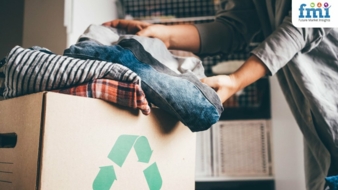12/09/2023 – Future Market Insights
Textile recycling as the problem solver
The textile recycling market size is projected to be worth US$ 4.8b in 2023. The market is likely to reach US$ 6.6b by 2033. The market is further expected to surge at a CAGR of 3.2% during the forecast period 2023 to 2033.
The textile recycling market is experiencing significant growth due to increasing environmental concerns regarding textile waste and a growing social awareness of the need for textile recycling. Government agencies and private companies are recognizing textile recycling as a solution to address textile waste management challenges. For instance, in the United States, the National Council of the American Textile and Garment Foundation highlights that discarded textiles contribute significantly to waste generation, prompting initiatives like the Council for Textile Recycling`s (CTR) goal to achieve zero waste by 2037.
Textile recycling market
Key drivers of the textile recycling market include innovative recycling technologies that improve fiber separation and dye removal, promoting higher-quality recycled textiles. The concept of a circular economy is gaining traction, with brands and manufacturers incorporating circular principles into their business models, driving demand for recycled yarn. Textile-to-textile recycling, aided by AI-based automation and grading technologies, is becoming more efficient. The market is also witnessing the rise of startups focusing on textile recycling, bringing innovative technology to address long-term challenges. Industry groups are launching campaigns to educate consumers and businesses about the benefits of textile recycling, promoting sustainability.
However, the textile recycling market faces challenges related to diverse materials, the quality of collected materials, and limitations in existing recycling technologies. The absence of standard identification or labeling systems for textiles may impede growth.
In a comparative view of adjacent markets, the textile recycling industry is poised to dominate, driven by rising consumer demand for eco-friendly products and sustainability awareness.
Best practices
In the United States, textile recycling is growing due to increased environmental awareness, and the market is witnessing advancements in recycling technology. Nonprofit organizations and public awareness campaigns play a vital role in promoting textile recycling.
The United Kingdom leads in circular fashion in Europe, with the government implementing measures to reduce the fashion industry`s environmental footprint. Initiatives like the Extended Producer Responsibility scheme and Textile 2030 aim to reduce the sector`s environmental impact. The competitive landscape of the global textile recycling market includes both large and small-scale players adopting strategies such as technology development, expansion, and mergers and acquisitions.
Collaborations between companies like Circ and Zara, Lenzing Group`s introduction of Lenzing “Ecovero”, and Birla Cellulose`s partnership with “TextileGenesis” highlight the industry`s innovative efforts towards sustainability and circularity.




